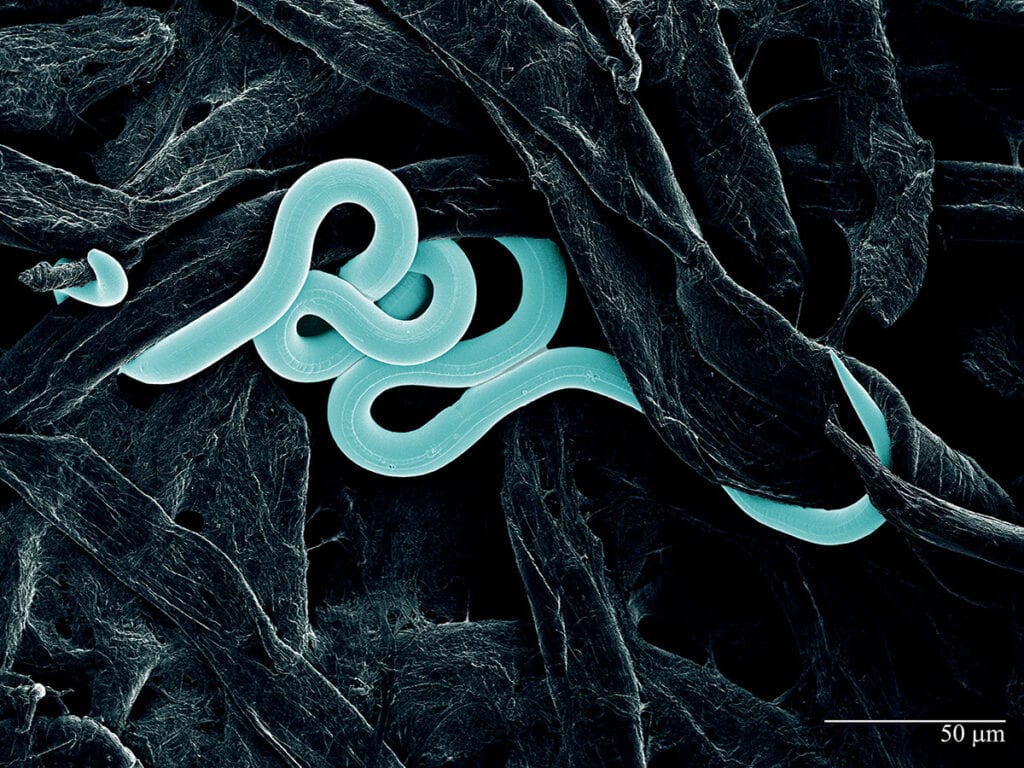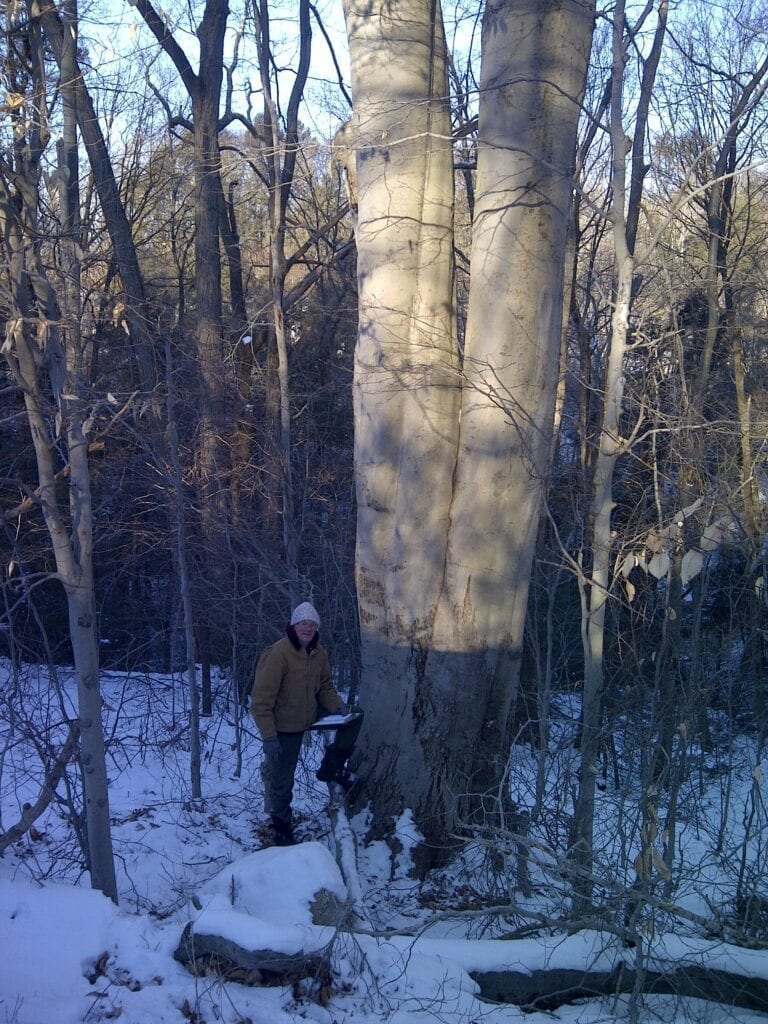A mysterious nematode first identified near Cleveland in 2012 has been spotted in seven Connecticut counties and Rhode Island this summer. The nematode has been tied to the deadly “Beech leaf disease” that has wreaked havoc on beech trees from Lake Erie to the Atlantic Ocean.
“We’re really concerned because we’re not left with much else in the forest now – oaks and hickories and birches, and then beeches,” said Robert Marra, a scientist with the Connecticut Agricultural Experiment Station.
Going back 150 years, there would have been abundant chestnuts, elms, ashes and walnuts, said Marra, but the northeastern forests have changed dramatically as new diseases and pests have been introduced.
Beech trees are prized as ornamental trees, but beechnuts are also an important source of fall and winter food for forest-dwelling animals from chipmunks to blue jays to black bears.
Beech leaf disease causes characteristic dark green lines between veins on American and European beech leaves infected by a particular nematode. The leaves turn yellow and become wrinkled and leathery, and will die when heavily infected. According to James LaMondia, a scientist with the research station, said that over time, the tree canopy will thin and the disease will infest the leaf buds, and may eventually kill the tree.

Marra said that he had identified the disease last summer in Stamford, Greenwich and New Canaan, but because the disease didn’t appear in adjacent forest, he assumed that was as far as it had spread. But this year, Marra and others have spotted Beech leaf disease in every county in Connecticut except Hartford County.
Beech trees are already facing a deadly fungal infection called beech bark disease.
How did it get here?
Beech leaf disease was first identified in Lake County, Ohio, in 2012. Cleveland Metroparks, including forest health project coordinator Dan Volk, have been tracking its spread since it was found in neighboring Cuyahoga County soon after.
In the Cleveland Metropark district, the disease appears to spread about 17 kilometers a year, Volk said. On a larger scale, it appears to be spreading much faster. It’s been identified in 14 Ohio counties, western Pennsylvania and New York, and southern Ontario. More recently, it’s been spotted in eastern New York, Long Island, Connecticut, Rhode Island and Massachusetts.
It’s not clear how the nematode that causes Beech leaf disease spread to the east, Volk said. There hasn’t been evidence of it in eastern Pennsylvania, so it’s not clear if it was carried a long distance, or if it hopped across Pennsylvania and New York and just hasn’t been identified everywhere, he said. The nematode may need water to travel, so there could have been separate introductions on Lake Erie and the Atlantic Ocean, Volk said.
And while Connecticut and Rhode Island have been dry this summer, there was a heavy outbreak in Rhode Island, where Beech leaf disease wasn’t seen at all last year, Marra said
“We really don’t understand at this point a lot about the life cycle,” said Lynn Carta, research plant pathologist for the USDA Agricultural Research Service in Maryland. “In particular, how the nematode is distributed within the tree within a season, as well as between trees and between geographic locations.”

Carta was the lead author of a February paper in the journal Forest Pathology that recorded an American population of nematodes closely related to one from Japan, and identified it as the cause of Beech leaf disease. She said beech leaf disease is different from other widespread forest diseases, like the fungal infections Dutch Elm disease or chestnut blight, because there is no microbial pathogen that researchers can identify.
“This is something that we’re still trying to understand how it does really get around,” Carta said.
Carta is preparing to release another paper showing mites entwined with the nematodes, which could be one way they’re being distributed. She said she hopes that generates some interest for researchers in the disease corridor to collect other invertebrates associated with the disease, to see if they might be carrying the nematodes.
It’s also possible birds are carrying the nematodes, something a group in West Virginia and Ohio is studying now. Wind and rain could also be important factors, especially in carrying nematodes from one leaf to another on the same tree, Carta said.
Researchers across the Beech leaf disease corridor have been collaborating in research, and more published research is on the way. One paper may be released in the next few months that will detail what happens inside the leaves to cause the characteristic damage, said Carta.
Lessons from Lake Erie
As researchers across the eastern United States study how the nematodes function, David Burke, Vice President for science and conservation at Holden Forests & Gardens near Cleveland, has been working with the U.S. Forest Service to try to find a way to control them, at least in ornamental beech trees.
Along with Bartlett Tree Service, Holden researchers have been testing the effectiveness of insecticides and nematicides on infested beech trees. So far, those injections haven’t worked well, which Burke said is disappointing, but likely a timing issue.
In the last test, insecticide was injected in the early spring and late September. It will be injected over the summer in the next test.
Nematodes are able to survive the winter inside the tree they’ve infested by moving from the leaves to the bud before the leaves fall, according to Burke and a March article in Forest Pathology. Holden researchers have collected nematodes from buds in February and March. When the new leaves emerge in the spring, they already have the characteristic damage of beech leaf disease, Burke said.

The March Forest Pathology article, co-authored by Burke, said the most nematodes were found at the end of the May-October growing season, increasing from a few nematodes per leaf to hundreds per leaf.
“September seemed like a good time to try insecticide, but we’re learning that the buds are being colonized as early as late August,” Burke said. “So it seems as though we should treat the trees before the buds begin to form.”
If researchers can find a pesticide that works, it can be helpful in saving landscape trees in a yard or a park. But a pesticide can’t be used to treat thousands of trees in natural forests, Burke said. What will happen to those trees is an open question, but there’s some evidence in Holden’s research plots that some beech trees are naturally resistant to the nematodes, he said.
“Some of our trees are severely impacted, and some are very lightly impacted – sometimes right next to each other,” Burke said. “And we’ve seen something similar in our natural areas. There’s a lot of trees that are heavily impacted, and then they come across other trees that look perfectly good.”
Help wanted
In Connecticut, Marra and his team have been scouring walking trails and roadsides for the characteristic leaf damage. There are places where a few leaves of a single tree in a forest show symptoms, and other places where almost every tree has many leaves showing symptoms, he said.
“We certainly have not covered anything close to every part of the state. We could never do that, that’s just beyond the scope of what we have the resources to do,” Marra said..
Cleveland Metroparks has developed the Tree Health Survey app to allow anyone to report sightings anywhere in the country directly to Volk, who will pass them on to state and local authorities.
Volk, with Cleveland Metroparks, said citizen input is crucial to tracking the spread. The first identification in Connecticut came from someone who was outside grilling on Memorial Day, and without them it might have remained undetected in Connecticut, Rhode Island and Massachusetts, he said.

